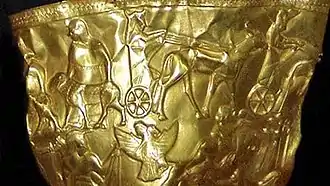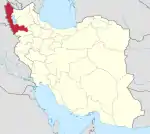Teppe Hasanlu
Teppe Hasanlu or Tappeh Hassanlu (Persian: تپه حسنلو) is an archeological site of an ancient city[1] located in northwest Iran (in the province of West Azerbaijan), a short distance south of Lake Urmia. The nature of its destruction at the end of the 9th century BC essentially froze one layer of the city in time, providing researchers with extremely well preserved buildings, artifacts, and skeletal remains from the victims and enemy combatants of the attack.
تپه حسنلو | |
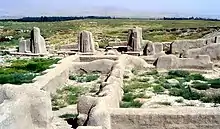 | |
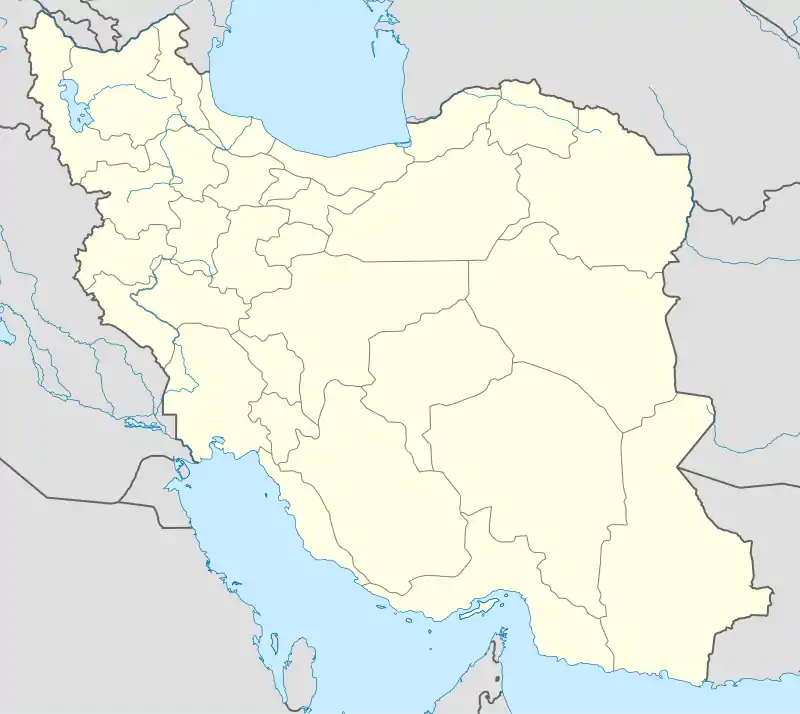 Shown within Iran | |
| Location | West Azarbaijan, Iran |
|---|---|
| Coordinates | 37°00′16″N 45°27′30″E |
| Type | Settlement |
Hasanlu Tepe is the largest site in the Gadar River valley and dominates the small plain known as Solduz. The site consists of a 25-m-high central "citadel" mound, with massive fortifications and paved streets, surrounded by a low outer town, 8 m above the surrounding plain. The entire site, once much larger but reduced in size by local agricultural and building activities, now measures about 600 m across, with the citadel having a diameter of about 200 m.[1]
The site was inhabited fairly continuously from the 6th millennium BC to the 3rd century AD. It is famous for the Golden bowl of Hasanlu.[2] Since June 2018, the Cultural Heritage, Handicrafts and Tourism Organization has pushed for the entire archeological site to be declared a UNESCO World Heritage Site.[3]
Name and etymology
The site is named after the nearby village of Ḩasanlū (Persian: حسنلو) . Tepe (Persian: تپه, also Romanized teppe, tappeh, etc.) is the Persian word for tell or hill, derived from Turkish.[4]
Archaeology
After some licensed commercial digging by dealers, the site was first dug by Aurel Stein in 1936.[5] The site of Hasanlu was then excavated in 10 seasons between 1956 and 1974 by a team from the University Museum, University of Pennsylvania and the Metropolitan Museum.[6][7] The project was directed by Robert H. Dyson, Jr. and is considered today to have been an important training ground for a generation of highly successful Near Eastern archaeologists.[8][9]
Originally, excavations in the Ushnu-Solduz Valley were intended to explore a series of stratified occupation levels in the area with the objective of reconstructing a regional cultural history from Neolithic times until Alexander the Great's conquest of Persia beginning in 334 BC, such that any conclusions would rely solely on material evidence from the region itself, independent of linguistic or literary evidence from adjoining regions.[10] The unexpected discovery of the famous "Gold Bowl" at Hasanlu in 1958 led to the project shifting its focus to the Iron Age levels at this site, although several other sites in the region were also excavated in order to stay in line with the project's broader objective. These other excavations were conducted at Dinkha Tepe, Dalma Tepe, Hajji Firuz Tepe, Agrab Tepe, Pisdeli, and Seh Girdan.
The Hasanlu Publications Project was initiated in 2007 to produce the official monograph-length final reports on the excavation.[11] Currently two Excavation Reports and several Special Studies volumes have been completed.[12][13][14][15]
Dalma Tepe
Dalma Tepe is a small mound located about 5 km southwest of Ḥasanlū Tepe, near the modern village of Dalma. It is approximately 50 m in diameter. It was excavated by Charles Burney and T. Cuyler Young, Jr., in 1958-1961.[16]
Large quantities of handmade, chaff-tempered pottery were found.[17] This includes 'Dalma plain ware', 'Dalma impressed ware', and 'Dalma red-slipped ware', which was covered with a uniform coat of dark-red paint. There was a variety of shapes.
'Dalma painted ware' is decorated with large patterns of triangles in deep shades on red.
Conical clay spindle whorls were also found.
Dalma pottery represents Period IX at Ḥasanlū Tepe, and is dated to around 5000-4500 BCE. Links with Level XVI at Tepe Gawra have been identified, which, in northern Iraq, represents Ubaid 3 period.[16]
Similar pottery has been found at Seh Gābī and Godin Tepe, attributed to Period X.
Kul Tepe Jolfa is another related site from the same period. It is located north of Lake Urmia.
History
The excavators originally divided the site’s occupation history into ten periods based on the nature of material finds in the different strata: the oldest, period X, stretches back to the Neolithic period, after which there was fairly continuous occupation until the early Iron Age (ca 1250-330 BC), followed by a hiatus before subsequent reoccupation; occupation finally ends in Iran’s medieval period (Hasanlu period I).[18]
Middle Bronze Age
Starting in the Middle Bronze III period or Hasanlu VIa (1600–1450 BC), there are important changes in material culture. This is best attested at the site of Dinkha Tepe, but is also present at Hasanlu. The most obvious change is the rapid abandonment of old styles of pottery, especially painted Khabur Ware, and the increased importance in producing monochrome unpainted pottery that is frequently polished or burnished. This ware is known as Monochrome Burnished Ware or, formerly, "Grey Ware"; however the ware occurs in a wide range of colors and thus is something of a misnomer.
Late Bronze Age
In the Late Bronze Age or Hasanlu Period V, Monochrome Burnished Ware came to dominate the ceramic assemblages of the Ushnu and Solduz valleys of the southern Lake Urmia Basin. Some scholars link changes in pottery forms to cultural contact with Assyria, this being a period of expansion for the Middle Assyrian kingdom, when such kings as Adad-nirari I (1295-1264 BC), Shalmaneser I (1263-1234 BC), and Tukulti-Ninurta I (1233-1197 BC) were conducting campaigns into the Zagros mountains to the south.[19] During this time, there was occupation on the High Mound and Low Mound of Hasanlu, and graves have been excavated at Dinkha Tepe and Hasanlu.
Iron Age
At around 1250 BC, there are some changes in the material culture at Hasanlu and in the graves excavated at Dinkha. This marks the beginning of the Iron I period, formerly identified with Hasanlu Period V but now the equivalent of Hasanlu IVc. While this period is designated the Iron I, there is virtually no iron in use during this period — two iron finger rings are known from Hasanlu. The High Mound of Hasanlu was almost certainly fortified during this period, and an internal gateway, large residential structures, and possibly a temple were located in this citadel. The Low Mound was also occupied, the best evidence of this coming from a house excavated in 1957 and 1959 dubbed the "Artisan's House". This structure derives its name from the fact that evidence for metalworking, primarily the casting of copper/bronze objects, was found there.
At the end of Hasanlu IVc/Iron I, Hasanlu was destroyed by a fire. Evidence of this destruction was discovered on the High and Low Mound. This destruction dates to around 800 BC and it marks the beginning of the Iron II period. While the destruction was extensive, the settlement's occupants seem to have rebuilt the citadel and the buildings of the Lower Town rapidly, cutting down the mudbrick walls of the burned structures to their stone footings and erecting new brick walls. The buildings of the Iron II settlement were based on their Iron I precursors, but were also larger and more elaborate in their layout and ornamentation. The primary example of this being the monumental columned halls of the citadel.
The continued presence in significant quantities of Assyrian goods or copies, alongside objects of local manufacture, attest to continued cultural contact with Assyria at this time; iron first appears in bulk at Hansanlu at around the same time Assyria seized control of the metal trade in Asia Minor.[20] While the Neo-Assyrian Empire was beginning a period of renewed power and influence in the 9th century, it is also at this time that the existence of the kingdom of Urartu, centered around Lake Van, is first attested in the Neo-Assyrian annals and related literature. By the time we hear about it, it is already a fully developed state - the circumstances attending its rise in the 2nd millennium are obscure.[21] Urartu’s expansion during this period brought the area south of Lake Urmia under its influence, although material finds at Hasanlu suggest that the city may have remained independent.[22] Nevertheless, Hansanlu was catastrophically destroyed,
We know a great deal about Iron II/Hasanlu IVb because of the violent sacking and burning at around 800 BC, probably by the Urartians.[23] Over 150 human victims were found where they had been slain. Some victims were mutilated and distributions of other bodies and the wounds they received suggest mass executions. Amid the burned remains of the settlement the excavators found thousands of objects in situ. Hasanlu IVb is a veritable Pompeii of the early Iron Age Near East. Some have suggested that the Iron II culture of Hasanlu, which has close ties to Mesopotamia and northern Syria, indicates the settlement came under the control of a foreign power, or experienced an influx of new occupants, or perhaps made internal changes to its political system.[19]
The Iron II settlement was fortified and was perhaps entered via a fortified road system located on the southwest side of the High Mound, although this interpretation of the archaeological remains of this area has come under increasing scrutiny in more recent analyses. Two areas of the citadel were investigated by the Hasanlu Project. In the west, buildings that served to control access into the citadel, a possible arsenal (Burned Building VII), and a large residential structure (Burned Building III) were investigated. South of this was Burned Building (BB) I and BB I East. These buildings formed a fortified gateway into the Lower Court area. BBI was also an elite residence. It was in this building in 1958 that the famous Gold Bowl of Hasanlu was discovered. The buildings of the Lower Court (BBII, BBIV, BBBIV East, and BBV) were arranged around a stone-paved court. Burned Building II likely served as a temple, and it was in this building that the excavators found over 70 massacred women and children — only a few adult males were found among the victims.
Following Hasanlu's destruction, the High Mound was used as the site for a Urartian fortress. A fortification wall with towers at regular intervals was constructed around the edges of the High Mound. Hasanlu was occupied fairly continuously during Period IIIa (the Achaemenid Period) and Period II (the Seleuco-Parthian Period).[24]
Photo gallery




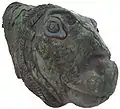 Bronze drinking vessel, Hasanlu, 1st mil BC. National Museum of Iran
Bronze drinking vessel, Hasanlu, 1st mil BC. National Museum of Iran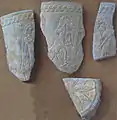 Egyptian blue, Hasanlu, 1st mil BC. National Museum of Iran
Egyptian blue, Hasanlu, 1st mil BC. National Museum of Iran crescent-shaped plaque, Hasanlu, early 1st mil BC. National Museum of Iran
crescent-shaped plaque, Hasanlu, early 1st mil BC. National Museum of Iran
See also
Notes
- The Cambridge History of Iran (ed. by W.B. Fischer, Ilya Gershevitch, Ehsan Yarshster). Cambridge University Press, 1993. ISBN 0-521-20091-1. Pages 57-58, 138.
- The Hasanlu Golden Bowl. Thirty Years Later, Expedition, vol. 31, no. 203, pp. 87-106, 1989
- "Millennia-old Hasanlu under restoration, landscaping project". Tehran Times. Aug 15, 2018. Retrieved May 20, 2020.
- https://www.nisanyansozluk.com/?k=tepe
- Aurel Stein, Old Routes of Western Iran. London: Macmillan, pp. 390-404, 1940
- Mary M. Voigt, Hasanlu I: Hajji Firuz Tepe, Iran--The Neolithic Settlement, Monograph 50, University of Pennsylvania Museum of Archaeology and Anthropology, 1983, ISBN 0-934718-49-0
- Michael D. Danti, Hasanlu II: The Ilkhanid Heartland: Hasanlu Tepe (Iran) Period I, Monograph 120, University of Pennsylvania Museum of Archaeology and Anthropology, 2004, ISBN 1-931707-66-9
- Oscar White Muscarella, Hasanlu 1964, The Metropolitan Museum of Art Bulletin New Series, vol. 25, no. 3, pp. 121-135, 1966
- Oscar White Muscarella, The Excavation of Hasanlu: An Archaeological Evaluation, Bulletin of the American Schools of Oriental Research, no. 342, pp. 69-94, 2006
- Dyson, Robert H (1989). "Rediscovering Hasanlu"; Expedition, Vol. 31, Nos. 2-3, pp. 3-11. (see external link, below)
- Hasanlu Publications Project;
- Irene J. Winter, Hasanlu Special Studies I: A Decorated Breastplate from Hasanlu, Iran, Monograph 39, University of Pennsylvania Museum of Archaeology and Anthropology, 1980, ISBN 0-934718-34-2
- Oscar White Muscarella, Hasanlu Special Studies II: The Catalogue of Ivories from Hasanlu, Iran, Monograph 40, University of Pennsylvania Museum of Archaeology and Anthropology, 1980, ISBN 0-934718-33-4
- Michelle I. Marcus, Hasanlu Special Studies III: Emblems of Identity and Prestige--The Seals and Sealings from Hasanlu, Iran, Monograph 84, University of Pennsylvania Museum of Archaeology and Anthropology, 1996, ISBN 0-924171-26-X
- Maude de Schauensee, Hasanlu Special Studies: Peoples and Crafts in Period IVB at Hasanlu, Iran, University of Pennsylvania Museum of Archaeology and Anthropology, 2011, ISBN 1-934536-17-2
- DALMĀ TEPE Encyclopædia Iranica
- T. Cuyler Young, Jr. (1963), Dalma Painted Ware penn.museum
- Hasanlu Publications Project: see 'overview' tab for chronology.
- Dyson, Robert H (1965). "Problems of Protohistoric Iran as Seen from Hasanlu"; Journal of Near Eastern Studies, Vol. 24, No. 3, pp. 193-9.
- Oscar White Muscarella, Hasanlu in the Ninth Century B. C. and Its Relations with Other Cultural Centers of the Near East, American Journal of Archaeology, vol. 75, No. 3, pp. 263-266, 1971
- Kuhrt, Amélie (1995). The Ancient Near East (Vol. 2); Routledge, New York, p.548ff.
- Dyson, Robert H (1989). "Constructing the Chronology and Historical Implications of Hasanlu IV"; Iran, Vol. 27, pp.18-9, 22.
- Inna Medvedskaya, Who Destroyed Hasanlu IV?, Iran, vol. 26, pp. 1-15, 1988
- Robert H. Dyson Jr., The Architecture of Hasanlu: Periods I to IV, American Journal of Archaeology, vol. 81, no. 4, pp. 548-552, 1977
References
- Danti, Michael, Hasanlu V: The Late Bronze and Iron I Periods, University of Pennsylvania Museum of Archaeology and Anthropology, 2013 ISBN 978-1-934536-61-2
- Robert H. Dyson Jr., The Achaemenid Painted Pottery of Hasanlu IIIA, Anatolian Studies, vol. 49, Anatolian Iron Ages 4. Proceedings of the Fourth Anatolian Iron Ages Colloquium Held at Mersin, 19–23 May 1997, pp. 101–110, 1999
- Oscar White Muscarella, A Fibula from Hasanlu, American Journal of Archaeology, vol. 69, no. 3, pp. 233–240, 1965
- Michelle I. Marcus, The Mosaic Glass Vessels from Hasanlu, Iran: A Study in Large-Scale Stylistic Trait Distribution, The Art Bulletin, vol. 73, no. 4, pp. 536–560, 1991
- Paul Collins, An Assyrian-Style Ivory Plaque from Hasanlu, Iran, Metropolitan Museum Journal, vol. 41, pp. 19–31, 2006
- Maude De Schauensee, A Note on Three Glass Plaques from Hasanlu. Iraq, vol. 63, pp. 99–106, 2001
- Vincent Pigott and Darrel J. Butterbaugh, A Programme in Experimental Mudbrick Preservation at Hasanlu Tepe, Iran, vol. 16, pp. 161–167, 1978
- Catherine Brahic (Sep 15, 2018). "Iran's Pompeii: Astounding story of a massacre buried for millennia". New Scientist.
External links
- Hasanlu Publications Project
- University of Pennsylvania Museum excavations at Hasanlu
- Expedition Magazine Special Issue (Vol.31 No.2-3): East of Assyria—The Highland
- More pictures, Tishineh Settlement of Hasanlu
